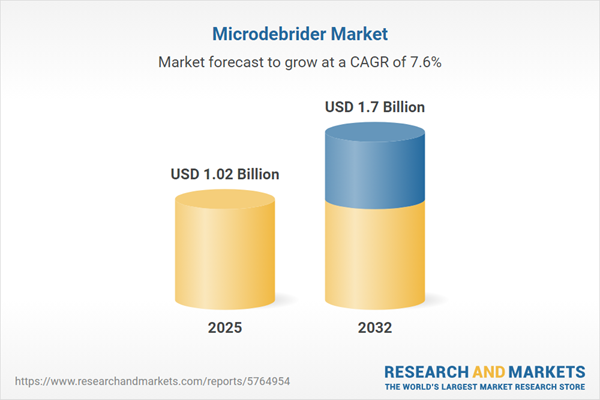Speak directly to the analyst to clarify any post sales queries you may have.
The microdebrider market is undergoing notable transformation as healthcare organizations seek greater precision and efficiency through advanced surgical systems. Demand for innovative microdebrider devices continues to grow as clinical practices shift toward minimally invasive techniques and integrated technologies for complex procedures.
Market Snapshot: Microdebrider Market Size & Growth
The microdebrider market expanded from USD 950.75 million in 2024 to USD 1.02 billion in 2025, reflecting sustained momentum. With a projected CAGR of 7.58%, the sector is expected to reach USD 1.70 billion by 2032. This steady growth is attributed to rising adoption across a range of surgical specialties, the push for minimally invasive approaches, and continuous device innovation that enhances clinical outcomes and reduces procedural times.
Scope & Segmentation of the Microdebrider Market
This research provides detailed analysis across multiple dimensions, facilitating strategic planning and targeted investments for stakeholders:
- Applications: ENT procedures, gynecological surgeries, orthopedic debridement, sports medicine interventions
- Product Types: Console microdebriders (multi-console, single-console), handheld microdebriders
- End Users: Ambulatory surgical centers (multi-specialty centers, single-specialty centers), clinics, private hospitals, public hospitals
- Distribution Channels: Direct sales models, distributor networks
- Geographies: Americas (United States, Canada, Mexico, Brazil, Argentina, Chile, Colombia, Peru), Europe (United Kingdom, Germany, France, Russia, Italy, Spain, Netherlands, Sweden, Poland, Switzerland), Middle East (UAE, Saudi Arabia, Qatar, Turkey, Israel), Africa (South Africa, Nigeria, Egypt, Kenya), Asia-Pacific (China, India, Japan, Australia, South Korea, Indonesia, Thailand, Malaysia, Singapore, Taiwan)
- Key Technology Providers: Smith & Nephew plc, Medtronic plc, Stryker Corporation, Olympus Corporation, KARL STORZ SE & Co. KG, CONMED Corporation, B. Braun Melsungen AG, Arthrex, Inc., Richard Wolf GmbH, Johnson & Johnson
Key Takeaways for Senior Decision-Makers
- Microdebrider innovation continues to enhance surgical precision, with integrated digital feedback and compatibility with advanced imaging supporting optimal outcomes in varied clinical settings.
- Progress in blade geometry and high-speed motor systems enables reduced operative times and improved safety, supporting increased use in both traditional and emerging surgical domains.
- Strategic partnerships between device manufacturers and software firms are driving interoperable solutions and regulatory compliance across international markets.
- Technology providers are leveraging acquisitions and licensing to broaden product portfolios, access robotics-enabled features, and expand clinical validation through collaborative research initiatives.
- Acceptance across diverse geographies is influenced by reimbursement frameworks, infrastructure upgrades, and government investments in healthcare modernization—especially in rapidly developing regions.
Tariff Impact: Supply Chain and Competitive Positioning
The 2025 United States tariff revisions have influenced cost structures for microdebrider imports, prompting manufacturers to consider diversified sourcing, supplier renegotiation, and nearshoring strategies. Operational adjustments include refined demand forecasting and proactive inventory management to address new logistical challenges and customs protocols. Market participants are adapting by rebalancing supply chains to maintain profitability and ensure continuity while navigating regulatory changes.
Methodology & Data Sources
Findings are grounded in a robust multi-stage approach, combining qualitative interviews with surgeons, procurement specialists, and regulatory officials, along with secondary research from industry reports and clinical registries. Triangulation and cross-validation confirm that strategic recommendations and trends reflect reliable, consensus-based market evidence.
The Microdebrider Market: Why This Report Matters
- Offers executives fact-based insights to refine procurement and technology strategy as surgical workflows evolve.
- Enables stakeholders to assess innovation benchmarks and supplier capabilities within a competitive, technology-driven sector.
- Supports accelerated decision-making by mapping emerging risks and opportunities tied to geographic adoption, tariff policy, and supplier innovation.
Conclusion
The microdebrider market is positioned for continued advancement, shaped by ongoing technological upgrades and dynamic regional demand. Thorough strategic analysis equips decision-makers to optimize value, resilience, and clinical adoption in surgical environments worldwide.
Additional Product Information:
- Purchase of this report includes 1 year online access with quarterly updates.
- This report can be updated on request. Please contact our Customer Experience team using the Ask a Question widget on our website.
Table of Contents
3. Executive Summary
4. Market Overview
7. Cumulative Impact of Artificial Intelligence 2025
Companies Mentioned
The companies profiled in this Microdebrider market report include:- Smith & Nephew plc
- Medtronic plc
- Stryker Corporation
- Olympus Corporation
- KARL STORZ SE & Co. KG
- CONMED Corporation
- B. Braun Melsungen AG
- Arthrex, Inc.
- Richard Wolf GmbH
- Johnson & Johnson
Table Information
| Report Attribute | Details |
|---|---|
| No. of Pages | 194 |
| Published | October 2025 |
| Forecast Period | 2025 - 2032 |
| Estimated Market Value ( USD | $ 1.02 Billion |
| Forecasted Market Value ( USD | $ 1.7 Billion |
| Compound Annual Growth Rate | 7.5% |
| Regions Covered | Global |
| No. of Companies Mentioned | 11 |









